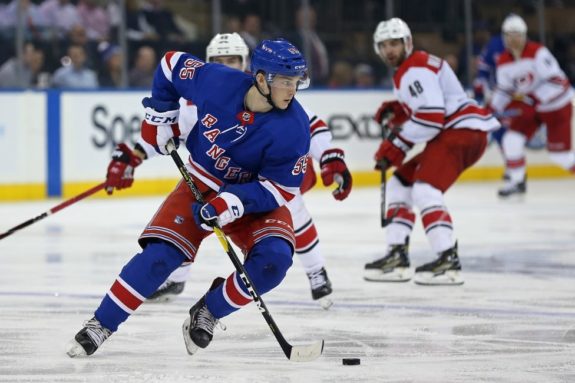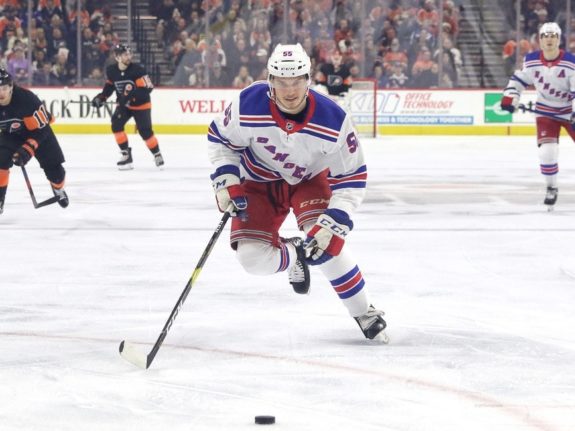The New York Rangers had an objectively strong trade deadline day. Keeping Chris Kreider and Jesper Fast are polarizing decisions, but ones that should immediately benefit the organization as it transitions past the rebuild. By keeping their wingers, they had to cut ties elsewhere in the lineup, which is where the Brady Skjei trade comes in. His departure means there will be enough cap space to re-sign necessary players come the offseason, but it also exposes youngster Ryan Lindgren and forces him into an inflated role for the rest of the season.

The Rangers are loaded with left-handed defensemen in their prospect system — Libor Hajek, Yegor Rykov, K’Andre Miller, Zachary Jones, and Matthew Robertson, just to name a few. The future on the left side of the blue line is as stable and deep as any roster in the league. However, the current state is far from any sign of stability. Following the Skjei trade, the Rangers will have Lindgren, Marc Staal, and defenseman/forward Brendan Smith to man the left side of their blue line. In all likelihood, one of Hajek or Rykov is called up from the Hartford Wolf Pack, but that still indicates the spotlight lies squarely on a 22-year-old rookie defenseman.
Lindgren’s Pre-Deadline Performance
Up until the deadline, Lindgren has been used as more of a depth defenseman with plenty of time on the penalty kill. Recently, he’s found relative success with Adam Fox as a 1A/1B type of pairing. There’s an argument to be made that they’ve evolved into the Rangers’ top pairing but the D-core is a pretty fluid rotation as far as which duo will get the most minutes at even strength.

Before the departure of Skjei, Lindgren had logged a single goal with 10 assists while averaging 16:25 time on ice over his 51-game campaign. The type of gritty, hard-nosed game that he plays doesn’t offer up much room for offense. If there’s one thing he particularly does well in, it’s knowing his role and purpose on the ice. He’s embodied the meaning of a stay-at-home defenseman by excelling at physicality in one-vs-one battles and pushing the perimeter while defending line rushes. There’s a reason why the Rangers’ locker room has dubbed him “The Warrior.”
Related: Predicting Rangers Opening Night Defense
He’s not one to make two-line passes very often, but he’s got a D-partner who can make up for that loss. All things considered, he’s been just okay during his rookie campaign. He’s done exceptionally well with bringing an extra edge to the Rangers blue line, but there are instances where his gap control is a bit too timid. That might be more of an issue with the coaching system than Lindgren’s personal hockey IQ.
Skjei brought plenty more offense, particularly this season as he’d already matched his career-high in goals and was on pace for just over 30 points. That being said, his shot suppression at 5v5 strength is marginally worse than Lindgren.
Skjei’s average 20:41 time on ice (TOI) will be difficult to replace, especially when the responsibility falls to either a defensive defenseman rookie, a 33-year-old who’s battled through injury this season, or a defenseman who’s played most of the season as a forward. Amongst those three, Lindgren should be the most obvious choice to shoulder the inflated role. How he performs the rest of the season is left to be seen, but the games against the New York Islanders and Montreal Canadiens provided a taste in how he’ll fare.
Lindgren’s Post-Deadline Performance
Thus far, the young defenseman has not disappointed in his inflated role. His 21:40 TOI led all Rangers against the Islanders and his 16:57 of 5v5 TOI was fourth amongst Rangers’ defenseman. He added two assists for his first multi-point performance of his NHL career and went plus-two. His first assist was one of the prettiest of his season as he patiently waited out the Islanders’ defenseman to commit to a shot block before finding Artemi Panarin on a cross-slot pass.
He led the blue line in relative high danger chance percentage and was third in expected goals forwarded percentage (xGF%). What’s particularly impressive about this is that the entire Rangers team had been dominated in both shot generation and possession metrics, but Lindgren was often an outlier. It’s worth noting that Fox and Lindgren have both excelled in preventing high danger chances — they lead the Rangers’ blue line in that particular metric this season.

His second game was equally promising as he repeated a two-assist performance en route to the Rangers’ 5-2 victory over the Habs. His 15:31 5v5 TOI and 19:10 total-TOI trailed only Jacob Trouba and Fox. He was second on the team in relative xGF% and was the only left-handed defenseman with a positive relative Corsi-percentage. His five blocked shots also sat at the top amongst Rangers defenseman. Unfortunately, he also led the team in giveaways with three.
In the two games, Lindgren logged four even-strength assists, averaged 20:26 TOI, 16:00 5v5 TOI, had a team-leading 55 shifts, seven blocked shots, and three hits. To put it simply, he has been thrust into an inflated role but continues to do what he does best — suppressing shots and keeping the threat to the outside. He’s also been getting more confident with the puck, evident by his two primary assists. If there’s any indication from his most recent performances, it’s that he’s more than capable of shouldering the load left by Skjei.
As the season progresses and teams become more desperate for wins, it’ll be interesting to see if Lindgren can continue his strong play. The Rangers’ schedule doesn’t get any easier as 14 of their final 19 opponents are currently in a playoff position. Should they stand a chance at making the playoffs and maintain their current pace, Lindgren will have to remain a reliant and consistent stream of defense for the Rangers’ weak left side of the blue line.